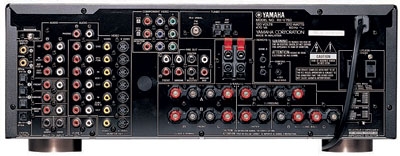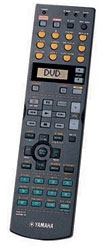Value-Packed Receivers Page 4
Yamaha RX-V750The Yamaha RX-V750's claim to fame is that it's the least expensive auto-calibrating A/V receiver you can buy. This means it can automatically select speaker "sizes," levels, distances, and all those other potentially confusing setup parameters that, when set properly, enable your system to sound its best. 
|
The V750 is a little bigger than the other two receivers but still more human-scaled than many full-featured A/V receivers - I liked that. The front panel is clean and simple, with only a handful of keys plus three knobs, a big one for volume and smaller ones for input and "program" (surround-mode) selection.
I was eager to try Yamaha's auto-setup routine, and it worked first time, every time. You simply plug the UFO-shaped microphone into the front-panel mike jack, call up the Setup menu onscreen, select Auto, and step back while the system works its magic. After about 4 minutes of noise bursts and clicks, the process is complete and a "Results" list comes onscreen to show you what the V750 selected. When I deliberately wired the right surround channel out of phase and ran the setup routine again, there it was on the Results screen flagged as a "Warning." Pretty cool.
The remote control is intelligently laid out, with a small, backlit LCD window that shows you what input you've selected or which source component you're controlling and direct-access keys for both inputs and surround modes. Thanks to the variations in key shapes and sizes, and the way they're grouped, it's easy to learn to associate functions with their keys. A good selection of no-nonsense, text-based onscreen displays helps you keep track of what's what and provides detailed feedback for tweaking the surround modes.
The Yamaha also delivers a pair of big pluses on the video side. First, the V750 can be set to "upconvert" incoming composite- or S-video signals to the higher-quality component-video format for output. Second, it sends all its onscreen displays to the component-video as well as the composite- and S-video output jacks - something not all receivers do. The payoff: you can make a single, three-wire component-video connection from the receiver to your TV and simply leave the latter set to its component-video input and never have to switch it - excellent!
 MOVIE PERFORMANCE Sound quality was excellent across the board. Like JVC, Yamaha features Dolby Pro Logic IIx, and playback in that mode was superb. (You can even toggle between DPL IIx and DPL II: very subtle, but very interesting. Plain-vanilla DPL II is so 20th century . . . .) The V750 passed my big-action power auditions without strain, yielding dynamic, high-impact sound with volume to spare in my 350-square-foot studio. All the big battle scenes from Master and Commander proved as exciting as you could want, and power was plentiful in all of my movie-sound torture tests.
MOVIE PERFORMANCE Sound quality was excellent across the board. Like JVC, Yamaha features Dolby Pro Logic IIx, and playback in that mode was superb. (You can even toggle between DPL IIx and DPL II: very subtle, but very interesting. Plain-vanilla DPL II is so 20th century . . . .) The V750 passed my big-action power auditions without strain, yielding dynamic, high-impact sound with volume to spare in my 350-square-foot studio. All the big battle scenes from Master and Commander proved as exciting as you could want, and power was plentiful in all of my movie-sound torture tests.
MUSIC PERFORMANCE Like most Yamaha receivers in the upper part of the line during the past decade and more, the V750 includes a pair of outputs for left and right Presence speakers, meant to be placed higher than the main front left/right pair and farther out to the sides. Many of its numerous DSP surround modes for music and its variations on standard Dolby Digital/DTS decoding for movies can generate special output signals for Presence speakers. Power is supplied by the pair of amplifier channels otherwise devoted to back surround speakers.
I did most of my listening with the Presence outputs turned off in favor of conventional 7.1-channel playback, both for more meaningful comparisons with the other two receivers and because most buyers, I suspect, won't use them. Nonetheless, I did install a pair of small two-way speakers in the Presence positions for my last few sessions. With DSP modes like Yamaha's Concert Hall, their presence (ouch!) does add an extra dimension - a sense of height to the sound field, which the Concert Hall mode even lets you adjust to taste. With a favorite stereo recording of Mahler's Fourth Symphony, the Concert Hall mode was gorgeously lifelike.
Overall, even without Presence speakers, Yamaha's DSP modes are simply the best you'll find in a mainstream A/V receiver. And like JVC, Yamaha includes a Night mode for all digital sources, not just Dolby Digital soundtracks. Its two settings, Cinema and Music, made low-volume listening possible without earstrain.
With its RX-V750, Yamaha is working both ends of the spectrum, offering an excellent auto-setup routine for the technophobe or neophyte and sophisticated options like extensive surround modes and video conversion for the experienced buff. Seems like a recipe for success to me.
- Log in or register to post comments




















































